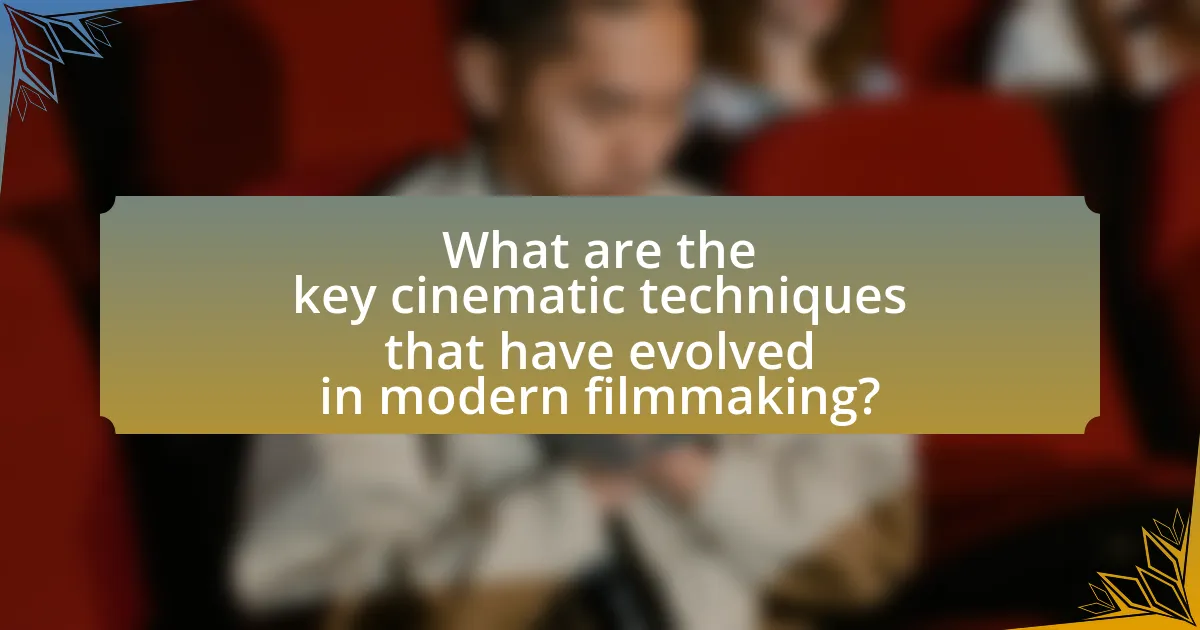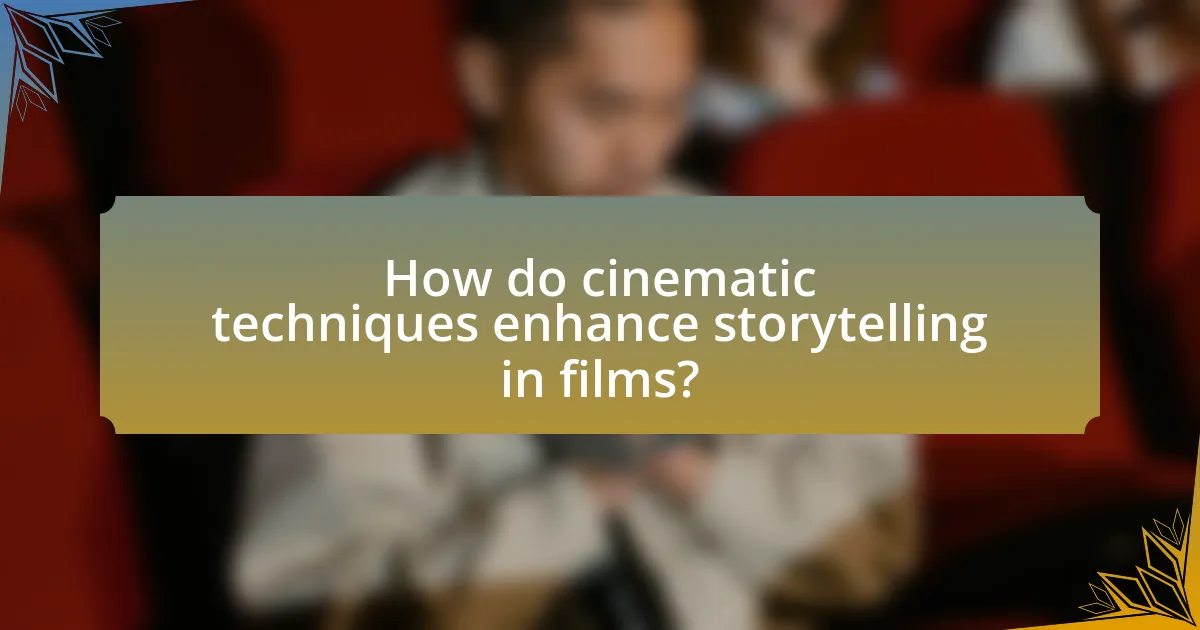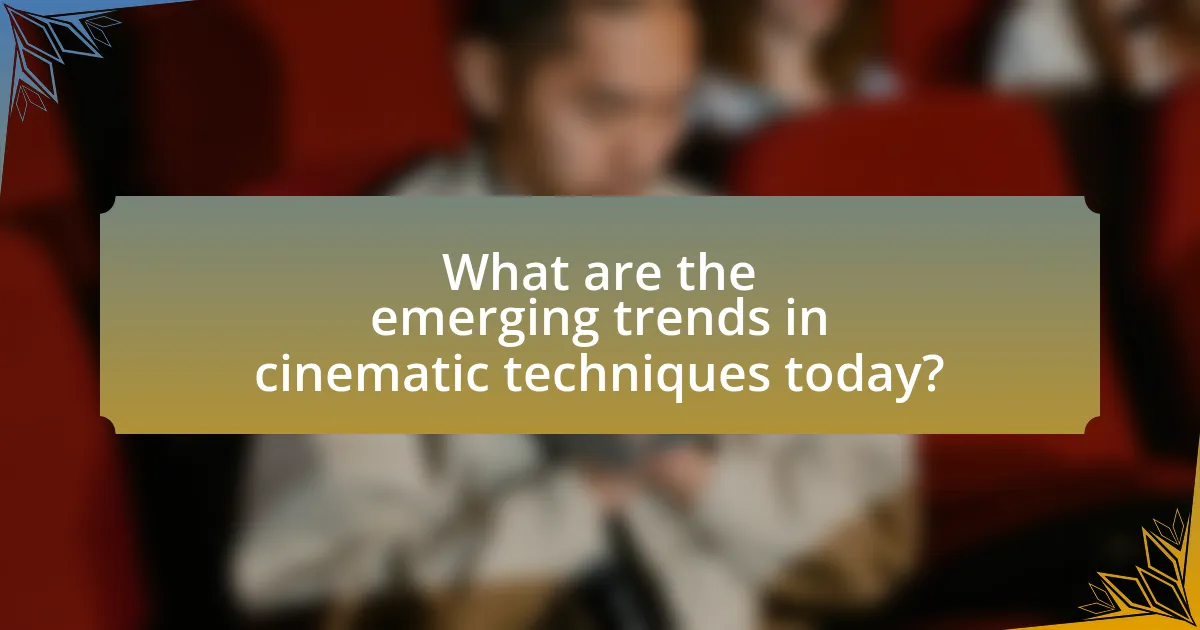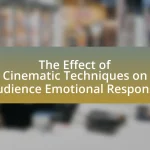The article focuses on the evolution of cinematic techniques in modern filmmaking, highlighting key advancements such as digital cinematography, CGI, and non-linear editing. It examines how technological innovations have influenced visual storytelling, production capabilities, and audience engagement, while also addressing the persistence of traditional techniques like practical effects and storyboarding. Additionally, the article explores the significance of sound design, editing techniques, and the impact of streaming technology on narrative structures. Emerging trends, including virtual reality and immersive storytelling, are discussed, along with best practices for filmmakers to remain relevant in a rapidly changing industry.

What are the key cinematic techniques that have evolved in modern filmmaking?
Key cinematic techniques that have evolved in modern filmmaking include digital cinematography, advanced CGI, and non-linear editing. Digital cinematography has replaced traditional film, allowing for greater flexibility and efficiency in shooting and post-production. Advanced CGI has transformed visual storytelling, enabling filmmakers to create realistic environments and characters that were previously impossible, as seen in films like “Avatar,” which utilized groundbreaking visual effects technology. Non-linear editing has revolutionized the editing process, allowing editors to manipulate footage more freely and creatively, exemplified by software like Adobe Premiere Pro and Avid Media Composer, which have become industry standards. These techniques collectively enhance the storytelling capabilities of filmmakers, making modern cinema more immersive and visually compelling.
How have advancements in technology influenced cinematic techniques?
Advancements in technology have significantly influenced cinematic techniques by enabling more sophisticated visual storytelling and enhancing production capabilities. For instance, the introduction of digital cameras has allowed filmmakers to capture high-resolution images with greater flexibility and lower costs compared to traditional film. This shift has led to a democratization of filmmaking, as seen in the rise of independent films that utilize affordable digital equipment. Additionally, advancements in computer-generated imagery (CGI) have transformed visual effects, allowing for the creation of complex scenes that were previously impossible, such as those seen in films like “Avatar,” which utilized groundbreaking CGI to create immersive worlds. Furthermore, innovations in editing software have streamlined the post-production process, enabling quicker and more creative editing techniques, as evidenced by the widespread use of software like Adobe Premiere Pro and Final Cut Pro in contemporary filmmaking. These technological advancements collectively enhance the artistic expression and narrative possibilities within the cinematic medium.
What role does digital cinematography play in modern filmmaking?
Digital cinematography plays a crucial role in modern filmmaking by enabling high-quality image capture and greater creative flexibility. This technology allows filmmakers to shoot in various lighting conditions, utilize advanced post-production techniques, and reduce costs associated with film stock and processing. For instance, digital cameras like the RED Epic and ARRI Alexa have become industry standards, providing filmmakers with the ability to shoot in resolutions up to 8K, which enhances the visual experience. Additionally, the immediacy of digital footage allows for real-time monitoring and adjustments, streamlining the production process. The transition from traditional film to digital has also democratized filmmaking, making it more accessible to independent creators and resulting in a broader range of storytelling.
How has the use of CGI transformed visual storytelling?
The use of CGI has transformed visual storytelling by enabling filmmakers to create immersive and fantastical worlds that were previously impossible to depict. CGI allows for the seamless integration of digital effects with live-action footage, enhancing narrative depth and visual appeal. For instance, films like “Avatar” and “The Lord of the Rings” utilized CGI to create entire ecosystems and mythical creatures, which significantly expanded the scope of storytelling in cinema. This technology has also facilitated more dynamic action sequences and complex visual effects, as seen in superhero films like “Avengers: Endgame,” where CGI was crucial in bringing characters and their powers to life. The ability to manipulate and enhance visuals through CGI has fundamentally changed audience expectations and experiences in film, making visual storytelling more engaging and imaginative.
What traditional techniques have persisted in modern cinema?
Traditional techniques that have persisted in modern cinema include practical effects, cinematography using film stock, and the use of storyboarding. Practical effects, such as makeup and animatronics, remain popular for their tangible realism, as seen in films like “Mad Max: Fury Road,” which utilized extensive practical stunts. Cinematography using film stock continues to be favored by some filmmakers for its unique aesthetic qualities, with directors like Christopher Nolan advocating for its use in projects like “Dunkirk.” Additionally, storyboarding, a technique that helps visualize scenes before filming, is still widely employed in the planning stages of modern films, ensuring a coherent narrative flow. These techniques demonstrate the enduring influence of traditional methods in contemporary filmmaking.
How do practical effects compare to digital effects in contemporary films?
Practical effects often provide a tangible, realistic quality that enhances viewer immersion, while digital effects offer flexibility and the ability to create complex visuals that may be impossible to achieve practically. In contemporary films, practical effects are frequently used for physical stunts, makeup, and animatronics, which can create a sense of authenticity, as seen in films like “Mad Max: Fury Road,” where practical stunts were a significant focus. Conversely, digital effects allow for expansive world-building and intricate visual sequences, as demonstrated in “Avengers: Endgame,” where CGI was essential for depicting large-scale battles and fantastical elements. The combination of both techniques is common, as filmmakers often blend practical and digital effects to achieve a desired aesthetic and narrative impact, ensuring that each method complements the other for optimal storytelling.
What is the significance of sound design in modern filmmaking?
Sound design is crucial in modern filmmaking as it enhances storytelling, creates atmosphere, and influences audience emotions. Effective sound design integrates dialogue, sound effects, and music to immerse viewers in the narrative, making them feel more connected to the characters and events. For instance, films like “A Quiet Place” utilize sound design to build tension and suspense, demonstrating its power in shaping viewer experience. Additionally, research from the University of Southern California highlights that sound can significantly affect audience perception and emotional response, underscoring its importance in cinematic techniques.

How do cinematic techniques enhance storytelling in films?
Cinematic techniques enhance storytelling in films by creating emotional depth, establishing tone, and guiding audience perception. Techniques such as camera angles, lighting, and editing shape how viewers interpret characters and events. For instance, low-angle shots can portray a character as powerful, while high-angle shots may suggest vulnerability. Additionally, the use of lighting can evoke specific moods; bright lighting often conveys happiness, whereas shadows can create suspense or tension. Editing techniques, such as cross-cutting, can build suspense by juxtaposing different storylines, thereby engaging the audience more deeply. These methods are supported by studies, such as those conducted by Bordwell and Thompson in “Film Art: An Introduction,” which illustrate how visual elements directly influence narrative comprehension and emotional engagement in cinema.
What impact do editing techniques have on narrative structure?
Editing techniques significantly shape narrative structure by influencing pacing, coherence, and emotional impact. For instance, techniques such as cross-cutting can create tension by juxtaposing different storylines, while linear editing maintains a straightforward narrative flow. Research by Bordwell and Thompson in “Film Art: An Introduction” illustrates how editing choices can manipulate time and space, thereby altering audience perception and engagement with the story. This demonstrates that the way a film is edited directly affects how the narrative is constructed and understood, ultimately guiding the viewer’s emotional journey through the film.
How does pacing influence audience engagement?
Pacing significantly influences audience engagement by controlling the rhythm and flow of a narrative, which affects viewers’ emotional responses and attention levels. When pacing is well-executed, it maintains suspense and interest, encouraging audiences to remain invested in the story. For instance, studies have shown that films with varied pacing, such as alternating between fast-paced action sequences and slower, reflective moments, can enhance emotional engagement and retention of information. This technique is evident in films like “Mad Max: Fury Road,” where rapid cuts and intense sequences are juxtaposed with quieter moments, effectively keeping the audience engaged throughout the film.
What are the effects of montage on storytelling?
Montage significantly enhances storytelling by compressing time and juxtaposing images to create meaning. This technique allows filmmakers to convey complex narratives efficiently, as seen in Sergei Eisenstein’s films, where rapid cuts evoke emotional responses and highlight thematic contrasts. For instance, in “Battleship Potemkin,” the Odessa Steps sequence uses montage to intensify the impact of violence and revolution, demonstrating how editing shapes audience perception and emotional engagement. Thus, montage serves as a powerful tool in modern filmmaking, facilitating deeper storytelling through visual rhythm and narrative compression.
How do camera movements contribute to the emotional tone of a film?
Camera movements significantly shape the emotional tone of a film by influencing audience perception and engagement. For instance, a slow, sweeping camera movement can evoke feelings of nostalgia or tranquility, while rapid, jerky movements may create tension or chaos. Research indicates that specific camera techniques, such as tracking shots or handheld movements, can enhance emotional responses by aligning the viewer’s experience with the characters’ emotions. For example, a study published in the Journal of Media Psychology found that films employing dynamic camera movements during critical emotional scenes resulted in heightened viewer empathy and emotional involvement. This demonstrates that the deliberate use of camera movements is a powerful tool in conveying and amplifying the emotional landscape of a film.
What are the different types of camera angles and their effects?
Camera angles are essential components in filmmaking that significantly influence the viewer’s perception and emotional response. Different types of camera angles include the eye level angle, which creates a neutral perspective; the high angle, which can make subjects appear vulnerable or weak; and the low angle, which often portrays subjects as powerful or imposing. Additionally, the bird’s eye view offers an overhead perspective that can provide context or emphasize isolation, while the Dutch angle creates a sense of unease or tension by tilting the camera. Each angle serves a specific purpose in storytelling, shaping the audience’s interpretation of characters and events. For instance, a study by Bordwell and Thompson in “Film Art: An Introduction” highlights how camera angles can manipulate audience emotions and narrative engagement, reinforcing the importance of these techniques in modern filmmaking.
How does the use of lighting shape the mood of a scene?
The use of lighting significantly shapes the mood of a scene by influencing the viewer’s emotional response and perception. Different lighting techniques, such as high-key lighting, create a bright and cheerful atmosphere, while low-key lighting can evoke feelings of suspense or drama. For example, in film noir, the use of stark contrasts and shadows enhances tension and mystery, demonstrating how lighting directly impacts the narrative tone. Studies in film theory, such as those by Bordwell and Thompson in “Film Art: An Introduction,” highlight that lighting not only illuminates subjects but also conveys psychological states and thematic elements, reinforcing the idea that effective lighting is crucial for mood establishment in cinematic storytelling.

What are the emerging trends in cinematic techniques today?
Emerging trends in cinematic techniques today include the increased use of virtual production, advanced CGI, and immersive storytelling through augmented reality (AR) and virtual reality (VR). Virtual production, exemplified by the use of LED walls in projects like “The Mandalorian,” allows filmmakers to create realistic environments in real-time, enhancing visual fidelity and reducing location costs. Advanced CGI continues to evolve, enabling more lifelike characters and environments, as seen in films like “Avatar: The Way of Water,” which utilized groundbreaking motion capture technology. Additionally, AR and VR are transforming audience engagement, allowing viewers to experience narratives interactively, as demonstrated by projects like “The Invisible Man” VR experience. These trends reflect a shift towards more innovative and immersive cinematic experiences, driven by technological advancements.
How is virtual reality changing the landscape of filmmaking?
Virtual reality is transforming the landscape of filmmaking by enabling immersive storytelling experiences that engage audiences in unprecedented ways. This technology allows filmmakers to create 360-degree environments where viewers can explore scenes interactively, enhancing emotional connections to the narrative. For instance, projects like “The Invisible Man” and “Wolves in the Walls” have utilized VR to provide unique perspectives that traditional filmmaking cannot achieve, demonstrating the potential for deeper audience engagement. Additionally, the integration of VR in film festivals, such as the Sundance Film Festival, showcases a growing acceptance and exploration of this medium, indicating a significant shift in how stories are told and experienced in cinema.
What are the challenges filmmakers face with VR technology?
Filmmakers face several challenges with VR technology, including high production costs, technical limitations, and audience engagement issues. High production costs arise from the need for specialized equipment and software, which can significantly increase budgets compared to traditional filmmaking. Technical limitations include the complexity of creating immersive environments and ensuring smooth user experiences, as VR requires advanced skills in 3D modeling and programming. Additionally, audience engagement issues stem from the fact that VR experiences can be isolating, making it difficult for filmmakers to replicate the communal viewing experience typical of traditional cinema. These challenges highlight the need for filmmakers to adapt their storytelling techniques and production processes to effectively utilize VR technology.
How does audience interaction redefine storytelling in VR films?
Audience interaction redefines storytelling in VR films by allowing viewers to actively participate in the narrative, transforming them from passive observers into engaged participants. This interactivity enables personalized experiences, where choices made by the audience can influence the storyline and outcomes, creating a unique narrative for each viewer. Research indicates that VR experiences with audience interaction can enhance emotional engagement and immersion, as evidenced by studies showing that participants in interactive VR narratives report higher levels of emotional involvement compared to traditional linear storytelling formats.
What role does streaming technology play in the evolution of cinematic techniques?
Streaming technology significantly influences the evolution of cinematic techniques by enabling filmmakers to reach wider audiences and experiment with new narrative forms. This technology allows for the distribution of content directly to viewers, bypassing traditional theatrical releases, which has led to the rise of serialized storytelling and innovative formats, such as interactive films. For instance, Netflix’s “Bandersnatch” exemplifies how streaming platforms encourage non-linear narratives, allowing viewers to make choices that affect the storyline. Additionally, the accessibility of streaming services has democratized filmmaking, allowing independent creators to produce and distribute their work without the constraints of traditional studios, thus fostering diverse cinematic expressions.
How has the rise of streaming platforms influenced production styles?
The rise of streaming platforms has significantly influenced production styles by prioritizing serialized storytelling and diverse content formats. Streaming services like Netflix and Amazon Prime have shifted the focus from traditional episodic structures to binge-worthy seasons, allowing for deeper character development and complex narratives. This change is evidenced by the success of shows such as “Stranger Things” and “The Crown,” which utilize cinematic techniques like high production values and extended runtimes to enhance viewer engagement. Additionally, the demand for varied genres and niche content has led to innovative approaches in production, as seen in the rise of international series that cater to global audiences, exemplified by “Money Heist” from Spain.
What are the implications of binge-watching on narrative techniques?
Binge-watching significantly alters narrative techniques by encouraging longer story arcs and character development over multiple episodes. This format allows creators to explore complex narratives that unfold gradually, as seen in series like “Breaking Bad,” where character transformation is central to the plot. Additionally, binge-watching promotes cliffhangers and suspenseful pacing, compelling viewers to continue watching without interruption. Research indicates that 70% of viewers prefer shows designed for binge-watching, which influences writers to craft episodes that maintain engagement across a season. This shift in viewing habits has led to a more serialized storytelling approach, emphasizing continuity and depth in character relationships and plotlines.
What best practices can filmmakers adopt to stay relevant in a changing industry?
Filmmakers can stay relevant in a changing industry by embracing technological advancements and diversifying their storytelling methods. Adopting new technologies, such as virtual reality and streaming platforms, allows filmmakers to reach wider audiences and create immersive experiences. For instance, the rise of streaming services has shifted viewing habits, with over 80% of audiences now consuming content online, according to a 2022 report by Statista. Additionally, incorporating diverse narratives and perspectives can resonate with contemporary audiences, as studies show that films with inclusive casts perform better at the box office. By continuously adapting to industry trends and audience preferences, filmmakers can maintain relevance and enhance their creative output.


